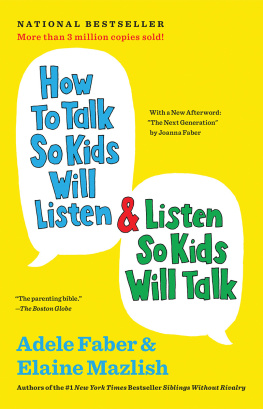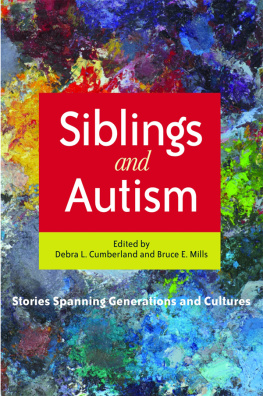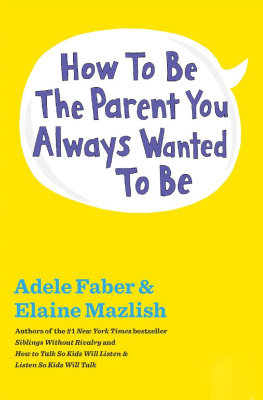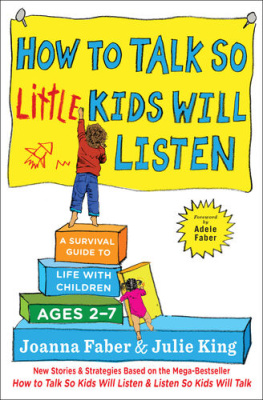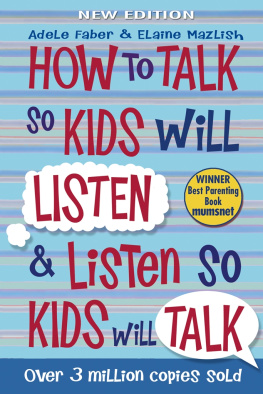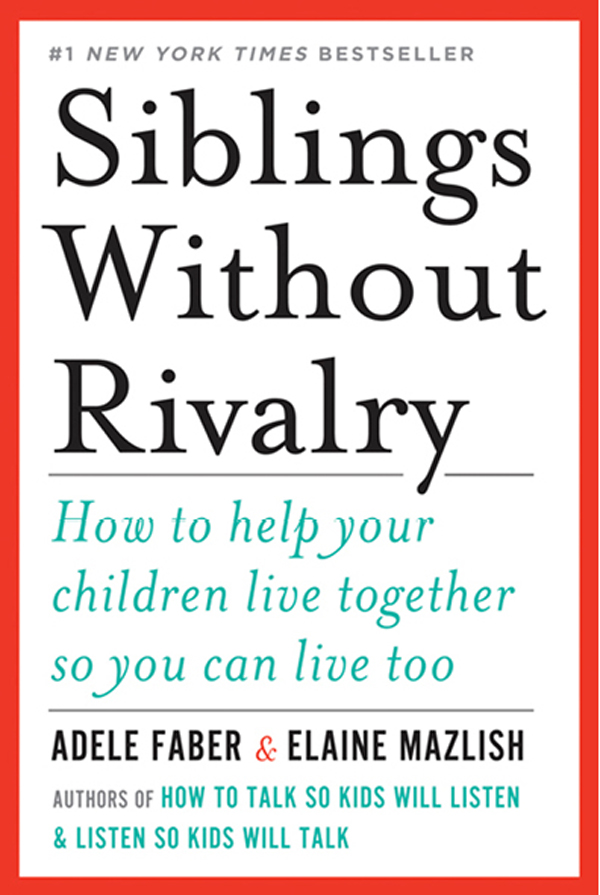
OTHER BOOKS BY ADELE FABER & ELAINE MAZLISH
Between Brothers and Sisters:
A Celebration of Lifes Most Enduring Relationship
Liberated Parents/Liberated Children:
Your Guide to a Happier Family
How to Talk So Kids Will Listen &
Listen So Kids Will Talk
How To Talk So Kids Can Learn
at Home and at School
How to Be the Parents You Always Wanted to Be
How to Talk So Teens Will Listen & Listen So Teens Will Talk
BOOKS FOR CHILDREN
Bobby and the Brockles
Bobby and the Brockles Go to School
Visit Adele Faber and Elaine Mazlish at
www.fabermazlish.com.
Siblings
Without
Rivalry

How to Help Your Children
Live Together So You Can Live Too
Adele Faber & Elaine Mazlish

W. W. Norton & Company
New York London
To all the grown-up siblings who still
have a hurt child inside them.
Contents
Behold how good and how pleasant it is
for brothers and sisters to dwell together in unity.
THE BOOK OF PSALMS
Wed Like to Thank...
Our husbands, for their ongoing support and encouragement of this project. They were a daily source of strength to us, especially when the going was slow.
Each of our offspring, who as young children provided us with the raw material for this book and who, as young adults, gave us valuable suggestions about what we might have done differently.
The parents in our groups for their willingness to explore with us and try out this new approach with their children. Their experiences and insights enrich these pages.
Everyone who shared with us their past and present feelings about their brothers and sisters.
Kimberly Ann Coe, our artist, who somehow was able to sense exactly what we were after in our cartoon illustrations, and create a lovable cast of parents and children.
Linda Healey, for being a writers dream editor, strong in her support of her authors message and style, gentle and persistent in her pursuit of excellence.
Robert Markel, for his unwavering support throughout our career and for his taste and judgment on which weve come to rely.
And finally, our mentor, the late Dr. Haim Ginott, who gave us our first vision of how the flames of sibling rivalry could be reduced to a small, safe flicker.
How This Book Came to Be
As we were writing How To Talk So Kids Will Listen & Listen So Kids Will Talk, we ran into trouble. The chapter on sibling rivalry was getting out of hand. We were only halfway through, and it was already over a hundred pages long. Desperately we went to work to shorten, tighten, eliminateanything to get it into proportion with the rest of the book. But the more we cut, the more unhappy we became.
Gradually the truth dawned on us. To do justice to sibling rivalry, wed have to give it a book of its own. Once that decision was made, the rest fell into place. We would put into How To Talk ... enough material on handling conflicts to ease parents over the roughest spots. But in our sibling book we would have room to stretch out, to tell about our early frustrations with our own battling kids; to describe the eye-opening principles we learned from the late child psychologist, Dr. Haim Ginott, in the years that we were part of his parent group; to share the insights we gained from our families, our reading, and our endless discussions with each other; and to describe the experiences of the parents who took part in the workshops we subsequently created and conducted on sibling rivalry.
It also occurred to us that we had an unusual opportunity through our nationwide speaking engagements to find out what parents around the country felt about sibling problems. We soon discovered we had a hot topic on our hands. Wherever we went, the very mention of the words sibling rivalry triggered an immediate and intense reaction.
The fighting drives me up the wall.
I dont know whatll happen first. Either theyll kill each other or Ill kill them.
I get along fine with each child individually, but when the two of them are together, I cant stand either one of them.
Evidently the problem was widespread and deeply felt. The more we talked to parents about what went on between their children, the more we were reminded of the dynamics that produced such high levels of stress in their homes. Take two kids in competition for their parents love and attention. Add to that the envy that one child feels for the accomplishments of the other; the resentment that each child feels for the privileges of the other; the personal frustrations that they dont dare let out on anyone else but a brother or sister, and its not hard to understand why in families across the land, the sibling relationship contains enough emotional dynamite to set off rounds of daily explosions.
We wondered, Was there anything to be said on behalf of sibling rivalry? It certainly wasnt good for parents. Was there something about it that might be good for children?
Everything we read made a case for the uses of some conflict between brothers and sisters: From their struggles to establish dominance over each other, siblings become tougher and more resilient. From their endless rough-housing with each other, they develop speed and agility. From their verbal sparring they learn the difference between being clever and being hurtful. From the normal irritations of living together, they learn how to assert themselves, defend themselves, compromise. And sometimes, from their envy of each others special abilities, they become inspired to work harder, persist and achieve.
Thats the best of sibling rivalry. The worst of it, as parents were quick to tell us, could seriously demoralize one or both of the children and even cause permanent damage. Since our book was going to be concerned with preventing and repairing any kind of damage, we felt that it was important to look once again at the causes of the constant competition among siblings.
Where does it all begin? The experts in the field seem to agree that at the root of sibling jealousy is each childs deep desire for the exclusive love of his parents. Why this craving to be the one and only? Because from Mother and Father, that wondrous source, flow all things the child needs to survive and thrive: food, shelter, warmth, caresses, a sense of identity, a sense of worth, of specialness. It is the sunlight of parental love and encouragement that enables a child to grow in competence and slowly gain mastery over his environment.
Why wouldnt the presence of other siblings cast a shadow upon his life? They threaten everything that is essential to his well-being. The mere existence of an additional child or children in the family could signify LESS. Less time alone with parents. Less attention for hurts and disappointments. Less approval for accomplishments. And most frightening of all, the thought: If Mom and Dad are showing all that love and concern and enthusiasm for my brother and sister, maybe theyre worth more than me. And if they are worth more, that must mean that Im worth less. And if I am worth less, then Im in serious trouble.
No wonder children struggle so fiercely to be first or best . No wonder they mobilize all their energy to have more or most . Or better still, ALL. Security lies in having all of Mommy, all of Daddy, all the toys, all the food, all the space.
What an incredibly difficult task parents confront! They have to find the ways to reassure each child that he or she is safe, special, beloved; they need to help the young antagonists discover the rewards of sharing and cooperation; and somehow they have to lay the groundwork so that the embattled siblings might one day see each other as a source of pleasure and support.
Next page

